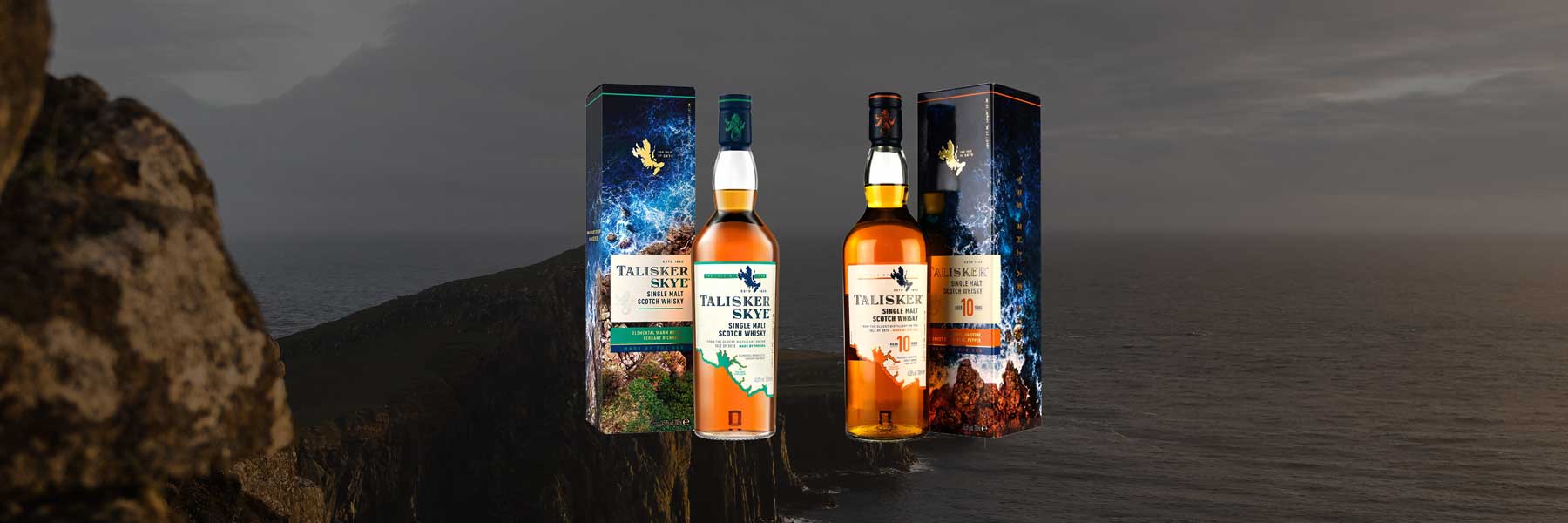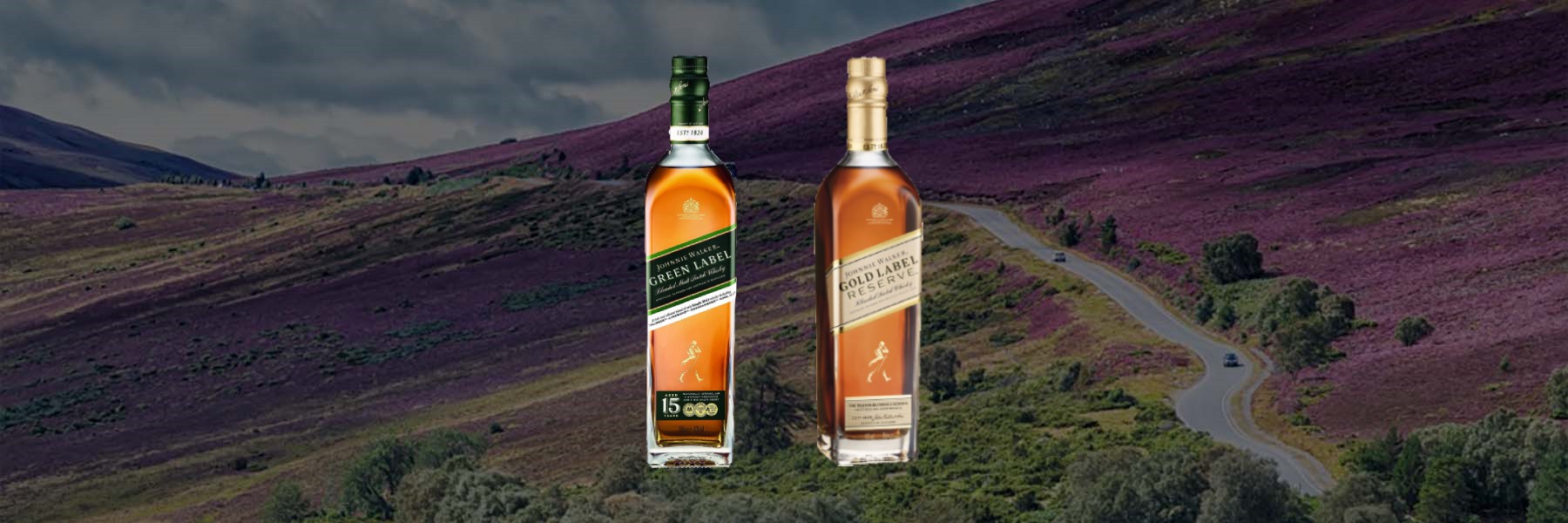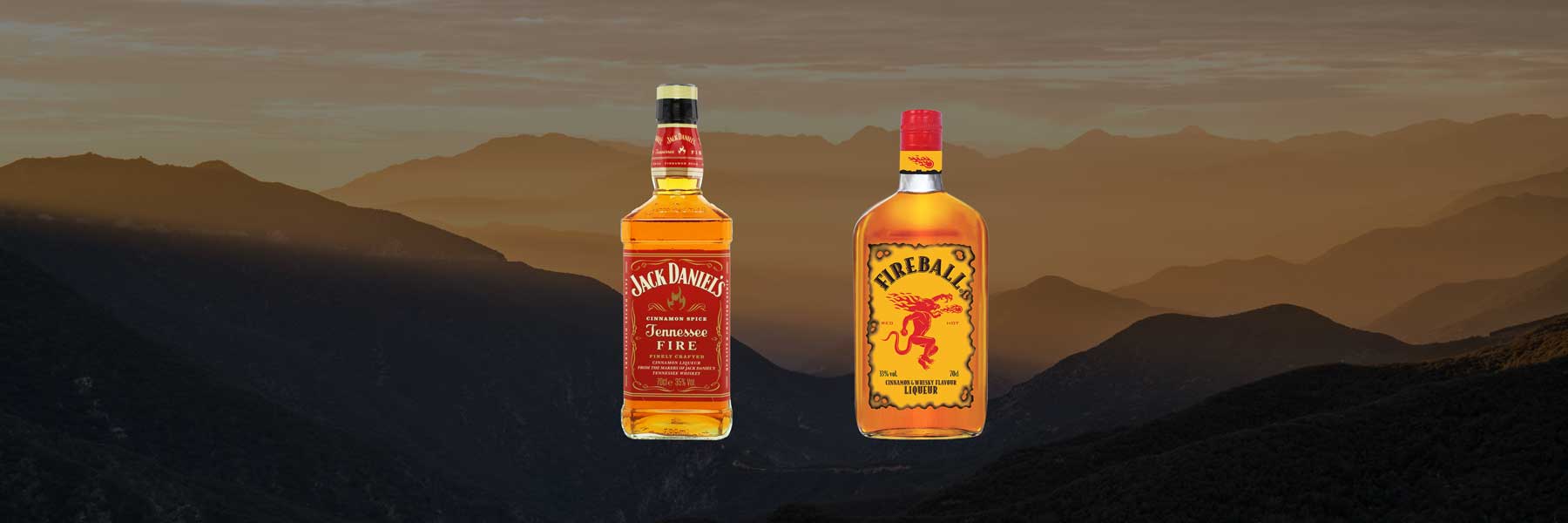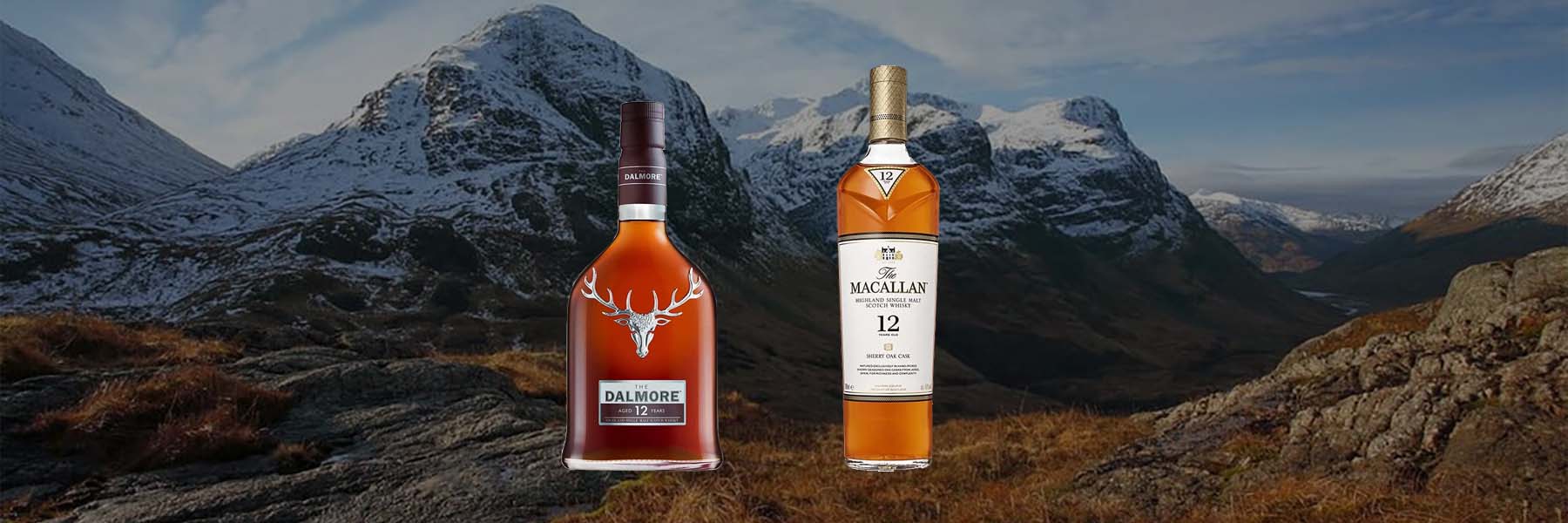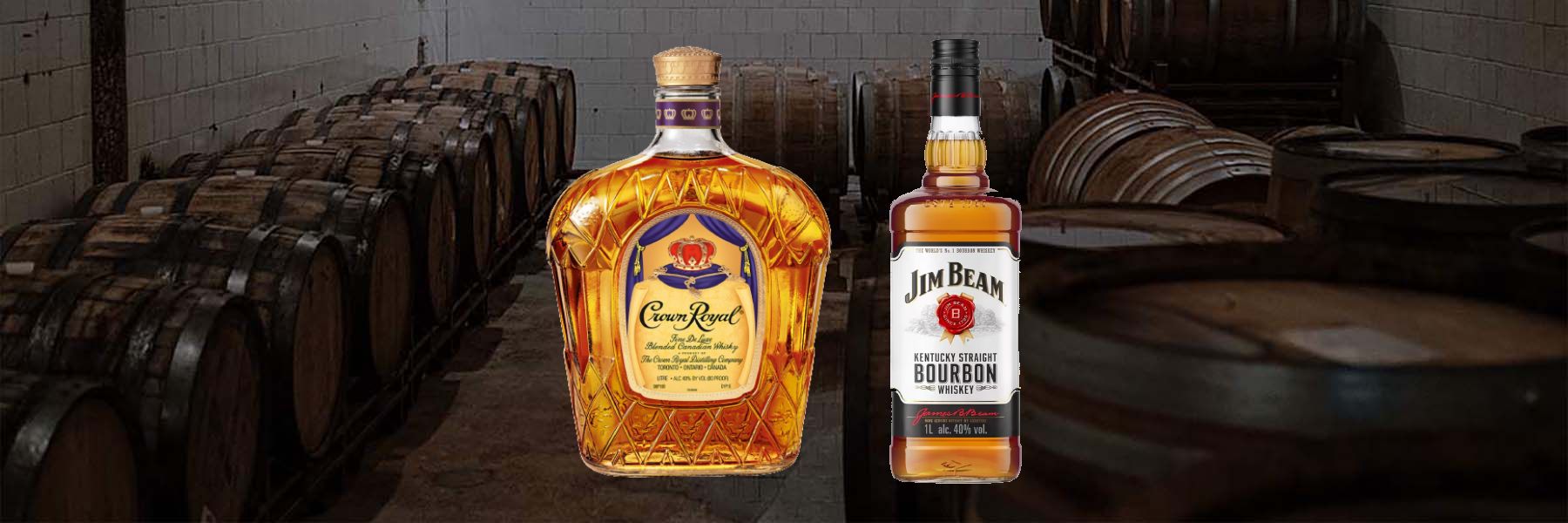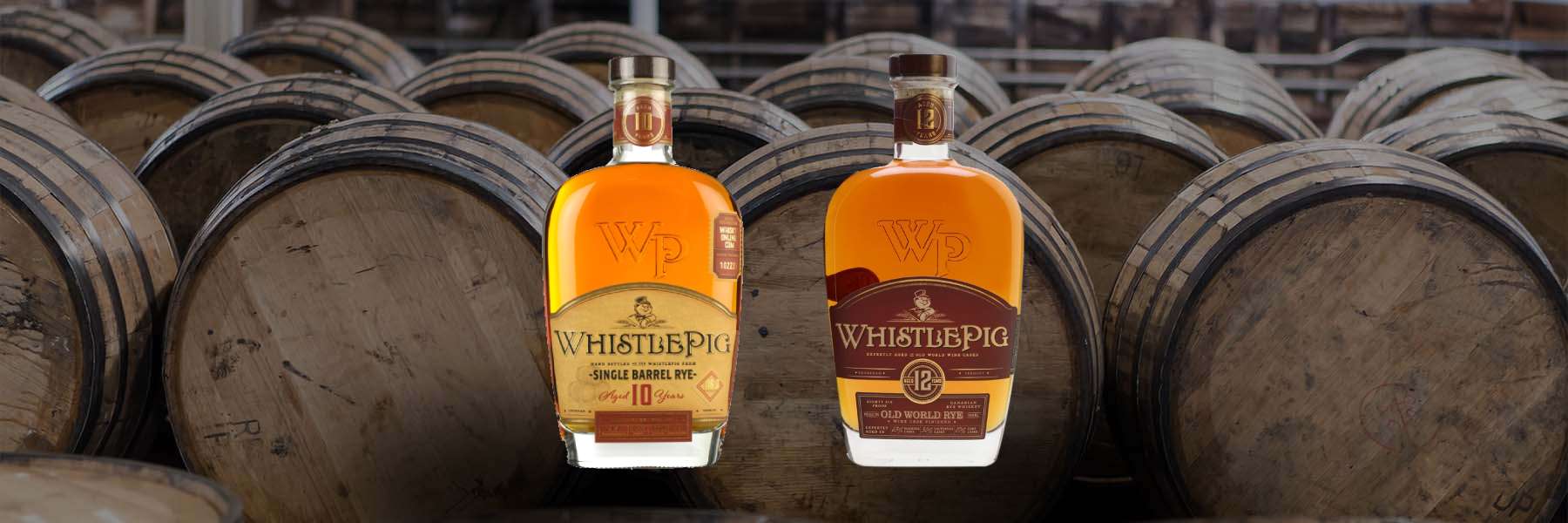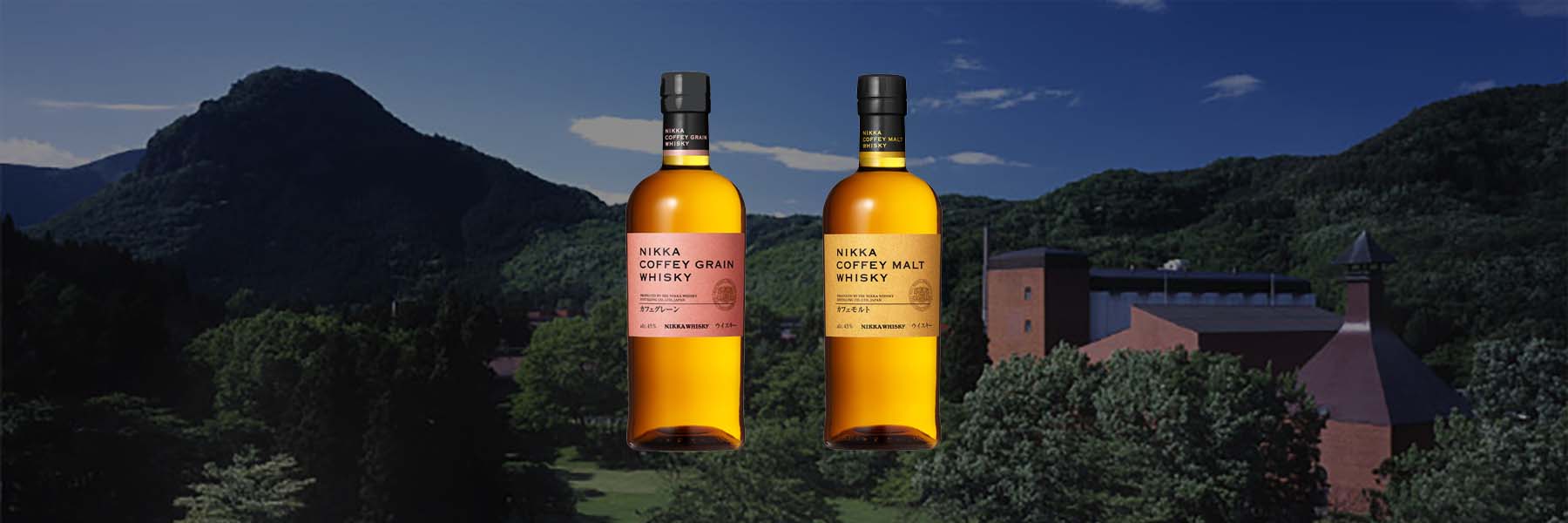Talisker Skye vs Talisker 10 | A Taste test which one is best?
Talisker is a well-known brand of single-malt Scotch whisky produced on the Isle of Skye in Scotland. The two expressions that will be discussed in this review article are Talisker Skye and Talisker 10. Both are highly regarded for their unique flavour profiles, which are influenced by the rugged landscape and maritime climate of the Isle of Skye.
This review article will compare and contrast these two expressions, examining their differences in taste, aroma, and overall character. In the battle between Talisker Skye vs Talisker 10 by the end you will gain an understanding of the distinctions between the two whiskies, and what makes them unique. We will also explore the history of Talisker and its place in the world of Scotch whisky.
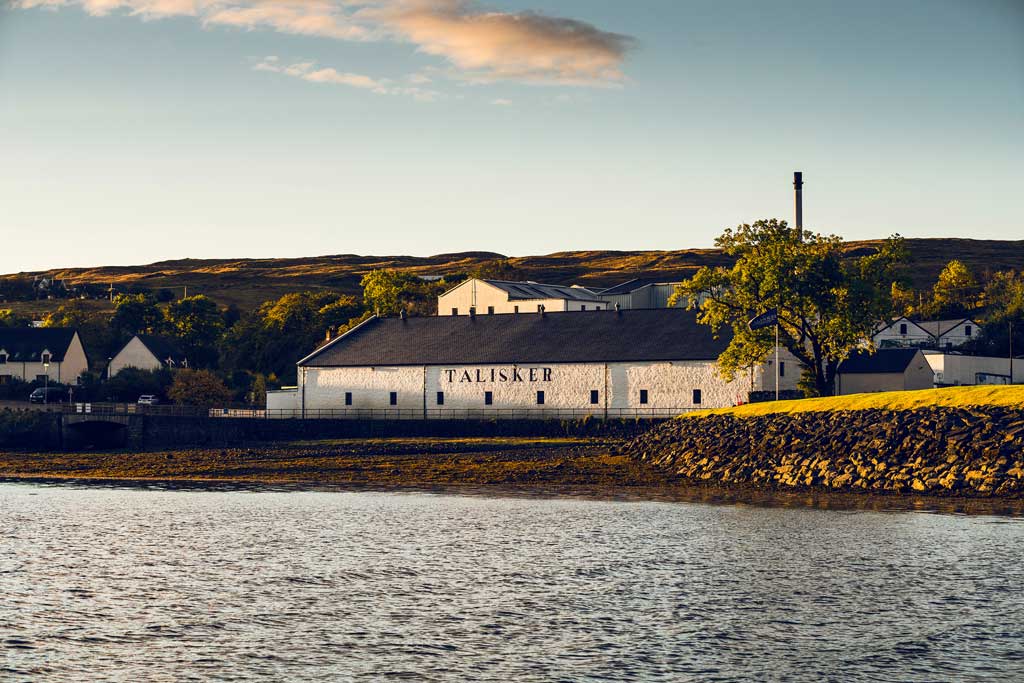
Talisker Whisky History
The history of Talisker dates back to the early 19th century when the MacAskill brothers established a distillery on the island in 1830. The distillery was named Talisker after the nearby Talisker Bay, and it quickly gained a reputation for producing high-quality whisky.
The Isle at the time had seven legal distilleries and numerous unregistered distilleries; whisky production was mostly a farm’s side activity.
In 1892, the distillery was sold to a group of investors led by John MacDougall and James Macandrew. They expanded the distillery and increased production, using the local water and barley to create a unique and flavorful whisky.
In 1960, Talisker was acquired by Distillers Company Ltd (DCL), which later became part of Diageo. Under Diageo’s ownership, Talisker continued to be produced on the Isle of Skye and remained a popular and highly regarded Scotch whisky.
The distillery was restored, and activities resumed in 1962 following a fire that occurred in 1960. Talisker 10 Year Old was produced in 1989 at a strength of 45.8% and marketed to symbolise the island whisky of the legendary malts series, which included six different varieties of whisky. Since then, many whisky lovers have fallen in love with the Talisker 10-Year-Old’s unmistakable flavour.
As time passed, Talisker was isolated as it became the only brewery on the Isle and had to rely entirely on its special ingenuity as it grew. Although the ownership of the brewery had changed numerous times, Talisker had developed a reputation to the point where John Anderson, a Glasgow realtor who purchased Talisker in 1863, asserted that “no other scotch on the market rivals the repute earned by Talisker.”
Today, Talisker is still produced at the original distillery on the Isle of Skye. It is known for its distinctive flavour, which is influenced by the island’s rugged landscape and maritime climate. Talisker offers a range of expressions, including the flagship Talisker 10, as well as Talisker Storm, Talisker Skye, and other special edition releases. Despite its long history, Talisker remains a popular and highly respected brand of single-malt Scotch whisky
Talisker Skye review
Talisker skye single malt was first released in 2015 as part of Talisker’s award-winning core range. Skye is a result of Talisker’s desire to explore the complexity and character that their location on the Isle of Skye offers.
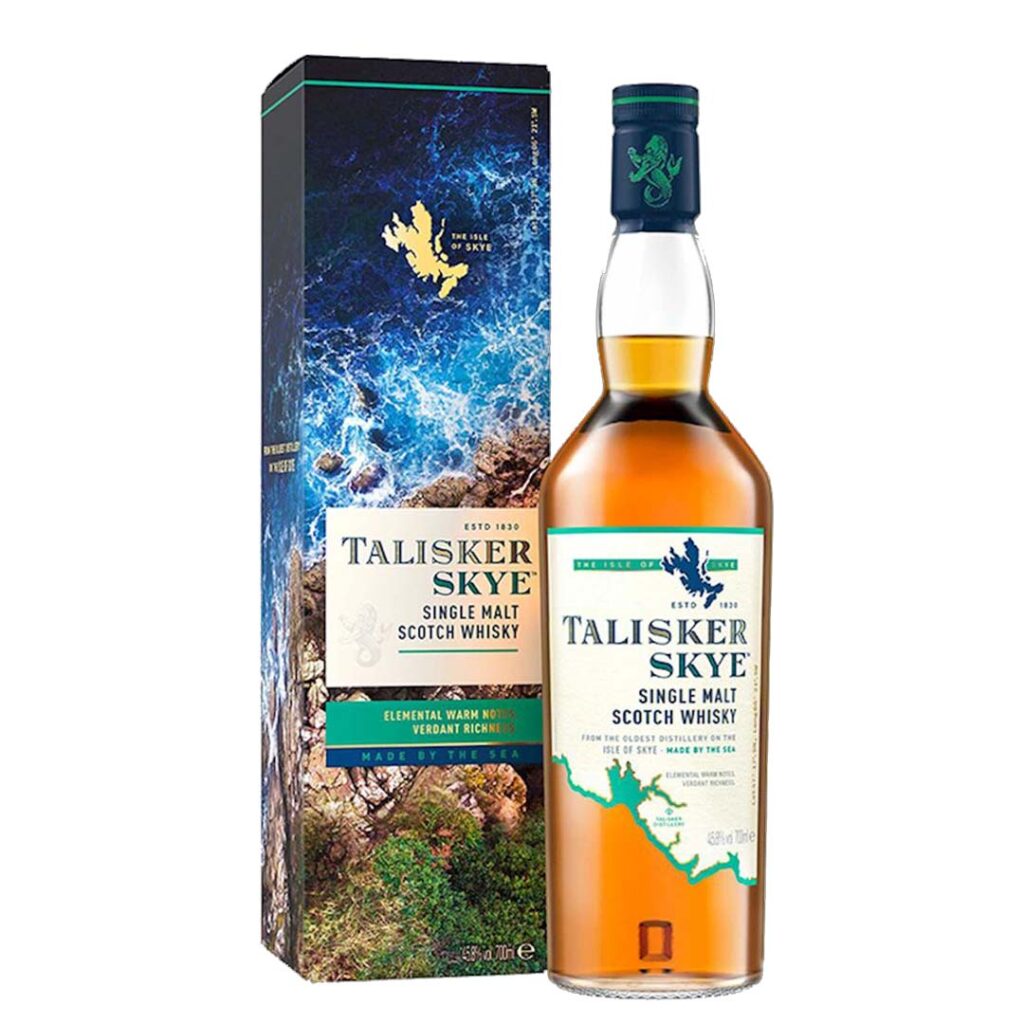
What age is Talisker Skye?
Talisker Skye was introduced in 2015 as a new expression of the brand. It is a non-age statement whisky, meaning that it is not specified by a specific number of years. Instead, Talisker Skye is a blend of whiskies aged in different types of oak casks, which gives it a unique flavour profile.
What does Talisker Skye taste like? It has a rich, spicy character with notes of toffee, honey, and sweet oak.
Talisker Skye is aged in a mix of refill and toasted American oak casks, with a slightly higher ratio of toasted casks compared to the original Talisker expression. This unique maturation process gives Talisker Skye a distinct flavour profile that may be more approachable for those who find the classic Talisker flavour profile too strong. However, fans of Talisker will also enjoy the unique character of Talisker Skye.
Talisker 10 review
Talisker 10 is the flagship expression of the Talisker brand. Instead, Talisker 10 is a blend of whiskies aged in different types of oak casks, which gives it a unique flavour profile. It is bottled at a strength of 45.8% ABV and is known for its robust and complex flavour profile.
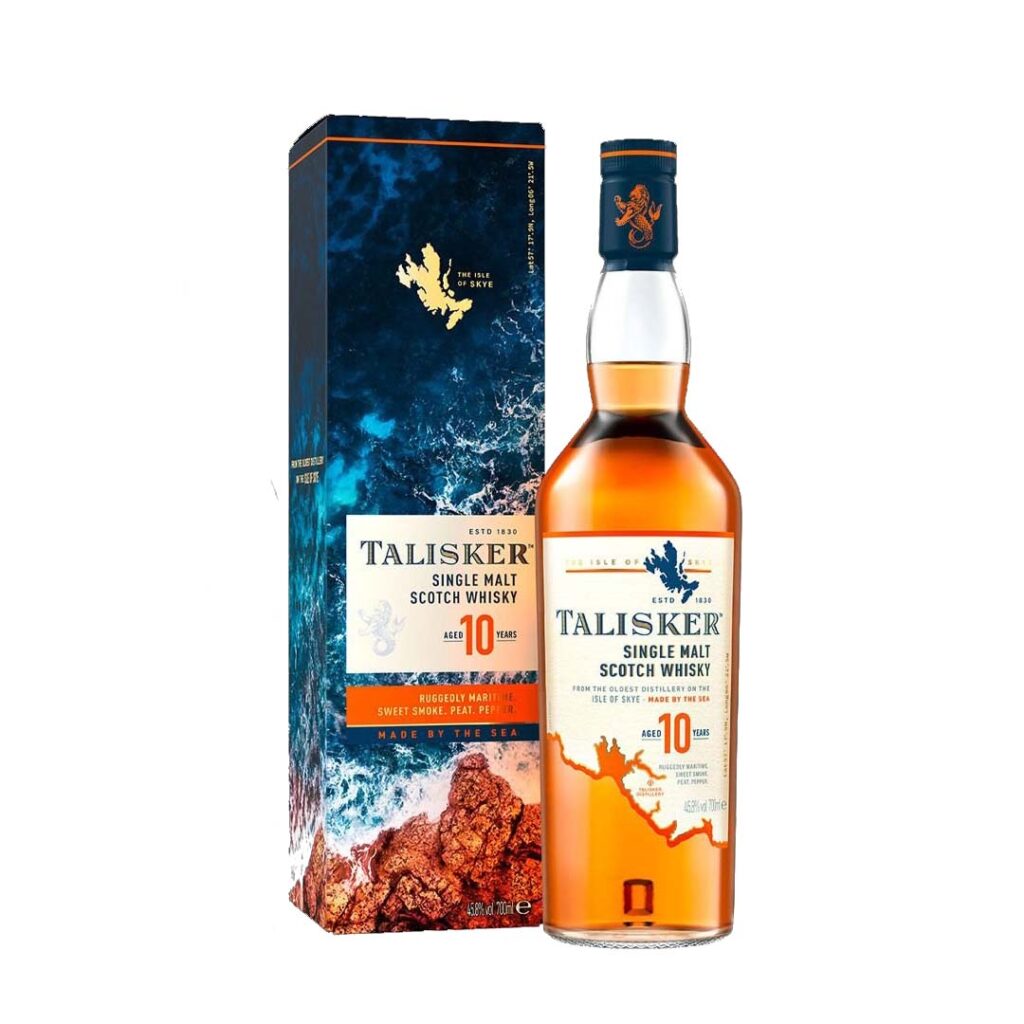
Talisker 10 has received numerous awards and accolades over the years, including multiple gold medals at the International Wine & Spirit Competition. It is widely regarded as one of the finest single-malt Scotch whiskies available and is a popular choice among whisky enthusiasts and collectors.
Is Talisker 10 Smokey?
It is characterised by its smoky flavour. Talisker 10 is crafted with Talisker’s signature smokiness, thanks to the peat smoke used during the distillation process. Talisker sources its peat for the 10 from the nearby bogs of Scotland’s west coast. This peat is harvested and then dried before being used in the distillation process, resulting in Talisker’s signature smokiness. Talisker is also known to source peat from other locations around Scotland.
Is Talisker smooth?
Talisker 10 is a smooth and well-balanced whisky with a complex aroma and flavour. It has an intense, smoky taste with notes of pepper and sea salt that are complemented by sweet flavours like vanilla, honey, and toffee. Talisker 10 is also characterized by a robust yet silky texture that lingers on.
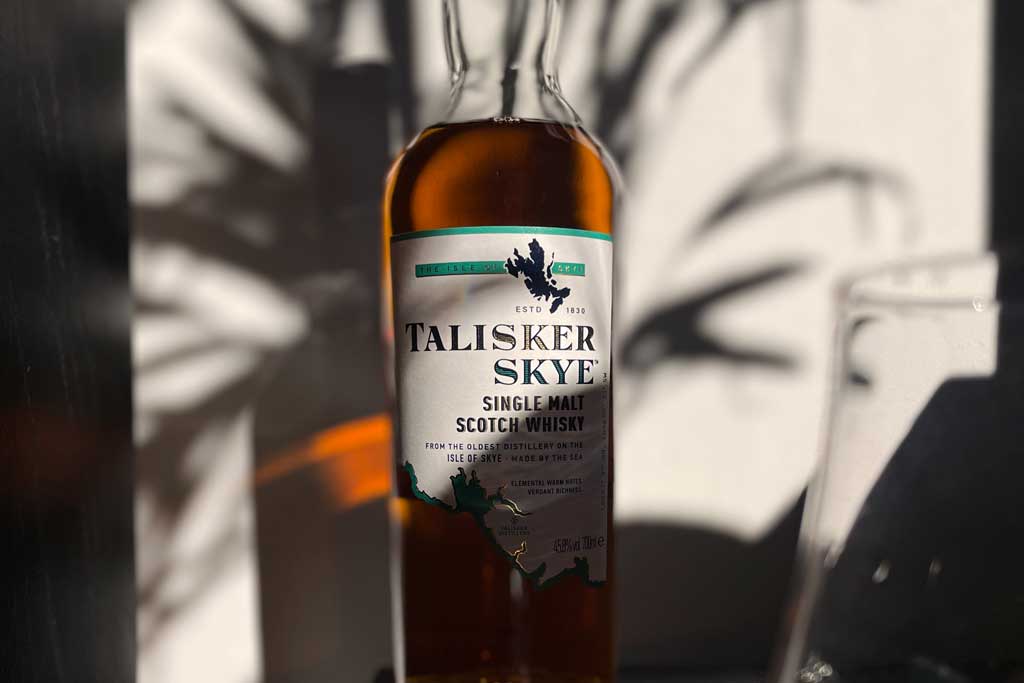
Talisker Skye Vs Talisker 10 Comparison
What is the difference between Talisker and Talisker Skye?
| Talisker Skye | Talisker 10 | |
| Nose | Clean, fresh. Hints of peaty earthiness, smoke, fresh fruits, salt, and honey. | The aroma of lemony peat, ground sea salt, and grilled salmon. A delightful nose. |
| Palate | Medium body, watery feeling, flat, salt, smoke. | The flavour is spicy and oily, with a subtle smokiness and a hint of brine. It has a distinct taste that is similar to licking the bricks of a pier. |
| Finish | Short to medium. There isn’t much variety; it mostly just lingers on the palate, albeit the backdrop of white pepper has become more pronounced. | Of average length. mostly salt and spicy smoke. |
| Rating | Very good 7.8/10 | 8.3/10 |
| Age | Non-age | 10 years |
| Region | Island | Island |
| ABV | 45.8% | 45.8% |
| Colour | Bright gold | Burnished |
| Classification | Single malt | Single malt |
| Cask | American oak cask | American oak cask |
| Chill Filtered | Yes | No |
| Price | $50.00/£40.90 | $53.73/£43.95 |
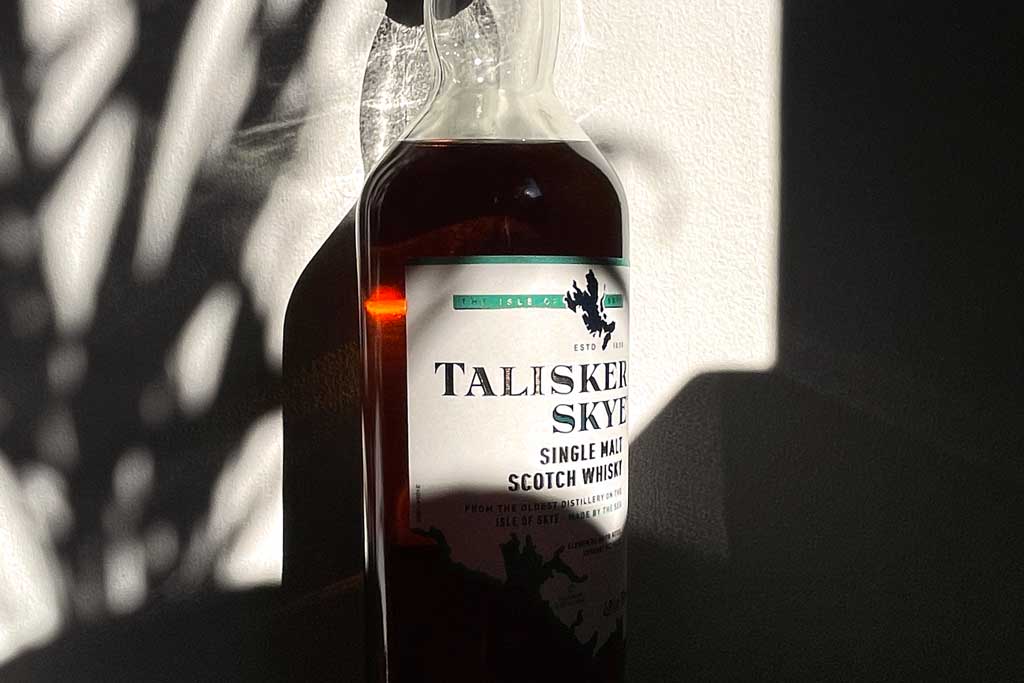
Tasting Notes: Talisker Skye vs Talisker 10
Nose: Talisker Skye is a lighter variant of Talisker 10. The flavour is relatively comparable, but fruity, oak, and smooth vanilla have taken the place of all the sharp edges. For bourbon aficionados, however, this bourbon-like aspect can make it a better first scotch. Despite the watery texture, it makes a fantastic transitional drink between sweet whisky and the considerably harsher Islay whiskies.
Palate: Talisker Skye first has a coating, tongue-tingling sweetness, and light smoke. It rapidly intensifies in heat, spiciness, and bitterness. While Talisker 10 has a warming, robust flavour of barley malt, clouds of smoke, and a rich taste of dried fruit. The back of mouth flavour is peppery.
Type of grain used:
The type of grain used to make Talisker Skye and Talisker 10 is malted barley. Malted barley is a type of barley that has been germinated and then dried in a kiln, which helps to develop the enzymes that are needed for the fermentation process. It is a key ingredient in the production of whisky, providing the sugars that are converted into alcohol during fermentation. Both Talisker Skye and Talisker 10 are made using 100% malted barley.
Production and Distillation process
Talisker Skye is aged in a mix of refill and toasted American oak barrels, with a slightly larger ratio of toasted barrels. It is peated to approximately 20 parts per million and does not have an age statement.
To make Talisker 10, the distillery begins by using malted barley as the primary grain in the whisky. The barley is then ground and mixed with hot water to create a mash, which is left to ferment in large tanks.
Next, the fermented liquid (known as a wash) is distilled in copper pot stills, which helps to separate and concentrate the alcohol in the wash. The resulting liquid, known as low wines, is then distilled a second time to produce the final whisky.
After distillation, the whisky is aged in oak barrels for at least 10 years. This ageing process helps to develop the flavour and character of the whisky and imparts notes of vanilla, spice, and other flavours from the oak barrels.
Once the whisky has reached the desired age, it is bottled and released as Talisker 10. The whisky is not chill-filtered, which helps to preserve its flavour and character.
Talisker Skye vs Talisker 10: Age
Talisker Skye does not have an age statement on the bottle, which means that it is a blend of whiskies of varying ages. In contrast, Talisker 10 is aged for at least 10 years, which means that all of the whiskies used in its production are at least 10 years old.
The age of a whisky can have a significant impact on its flavour and character. Younger whiskies tend to be more light and floral, with notes of fruit and citrus. As a whisky ages, it takes on more complex flavours and aromas from the oak barrels in which it is aged, such as vanilla, spice, and toffee.
As a result, Talisker 10 is likely to have a more consistent flavour profile, with prominent notes of oak and vanilla, while Talisker Skye may be more complex and varied in its flavour due to the mix of younger and older whiskies in the blend.
Talisker Skye vs Talisker 10: Flavour and aroma
Talisker 10 is likely to have a more consistent flavour profile, with prominent notes of oak and vanilla, as well as hints of pepper, citrus, and smoke. The aroma may also be dominated by oak and vanilla, with hints of salt and seaweed, which are characteristic of whiskies from the Isle of Skye.
In contrast, Talisker Skye has a more complex and varied flavour profile due to the mix of younger and older whiskies in the blend. It has notes of fruit, such as citrus and berries, as well as hints of smoke and peat. The aroma may also be more complex, with a mix of fruit, smoke, and seaweed.
Talisker Skye vs Talisker 10: Mouthfeel and finish
Talisker 10 has a medium to full body, with a rich, oily mouthfeel. The finish is long and lingering, with notes of pepper, smoke, and oak.
In contrast, Talisker Skye has a slightly lighter body, with a more delicate mouthfeel. The finish is slightly shorter, with a mix of fruit, smoke, and peat.
Talisker Skye vs Talisker 10: Food pairing
While it pairs well with barbecues and fantastic barbeque staples like pulled pork, smoked chicken wings, and brisket, Talisker Skye is best alongside smoked canapés, grilled fish, or sausage patty with teriyaki sauce. While seafood dishes like freshly shucked oysters go well with Talisker 10. Additionally, Comté cheese pairs quite well with it.
Talisker Skye vs Talisker 10: How to drink
Generally, you can drink Talisker in the following ways:
- Straight
- With soda
- On the rocks
- With water
Just like any whisky, the best way to enjoy Talisker is to taste it neat, without any ice or mixers, to fully appreciate its flavour and aroma. You can also try adding a few drops of water to the whisky to help open up the flavours. Sip slowly and savour the taste, allowing the whisky to coat your mouth and tongue before swallowing. You can also try drinking it on the rocks (with ice) or mixed in a cocktail if you prefer. Ultimately, the best way to drink any whisky is however you enjoy it most.
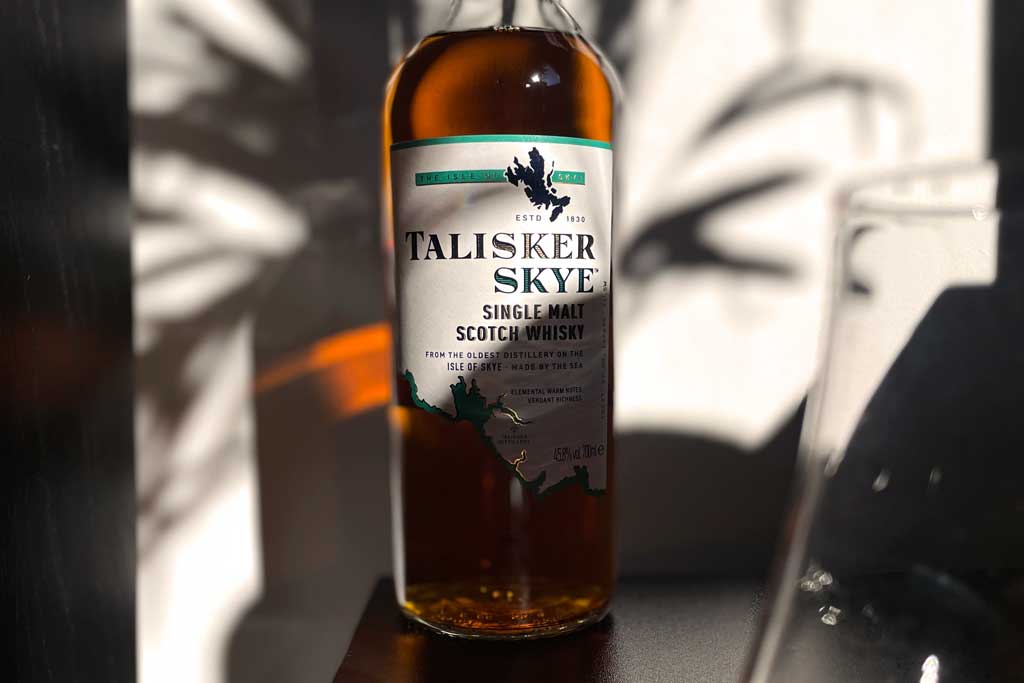
Talisker Skye vs Talisker 10: Which is better?
Talisker Skye and Talisker 10 are high-quality whiskies with distinct and complex flavour profiles. Talisker Skye is a more refined and smooth whisky, with a rich, balanced flavour that is well-suited to sipping neat or on the rocks. Talisker 10, on the other hand, is bolder and more assertive, with a fiery peatiness that makes it a great choice for whisky enthusiasts who like their spirits with a bit of a kick.
It is worth noting that Talisker Skye is a newer release from the Talisker distillery and does not have an age statement, indicating that it is a blend of whiskies of varying ages. In contrast, Talisker 10 is a younger whisky that has been aged for at least 10 years, giving it a more consistent flavour profile.
Overall, both Talisker Skye and Talisker 10 are single malt whiskies, with the main difference between them being the age of the whisky used in their production.
The question of which is better will largely depend on individual differences as both whiskeys are high-quality spirits from the same region.
In conclusion, Talisker Skye and Talisker 10 are both single malt whiskies produced by the Talisker distillery on the Isle of Skye in Scotland. The main difference between the two is the age of the whisky used in their production. Talisker 10 is aged for at least 10 years, while Talisker Skye does not have an age statement, indicating that it is a blend of whiskies of varying ages.
As a result, Talisker 10 is likely to have a more consistent flavour profile, with prominent notes of oak and vanilla, as well as hints of pepper, citrus, and smoke. The mouthfeel and finish may also be richer and more full-bodied.
In contrast, Talisker Skye may have a more complex and varied flavour profile, with a mix of fruit, smoke, and peat. The mouthfeel and finish may be slightly lighter and more delicate.
Ultimately, the best way to determine the differences between these two whiskies is to taste them side by side and evaluate their flavour, aroma, mouthfeel, and finish for yourself.
If you enjoyed this article then why not check out our others:


